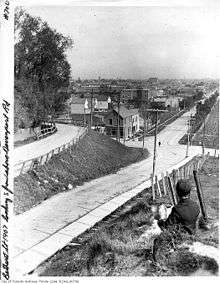Davenport Road

| Wikimedia Commons has media related to Davenport Road, Toronto. |

Davenport Road is a road in Toronto that follows a native trail along the foot of the scarp of the old shoreline of Lake Iroquois.[1][2] It currently runs from Yonge Street to Old Weston Road.
The road follows the longest First Nations trail to exist in Ontario. It was known as "Gete-Onigaming," Ojibwe for "at the old portage."[3] The trail, which continued along the modern route of Kingston Road east of the Don River, and what is now Dundas Street west of the Humber River. The Toronto portion of the trail had several earlier names, including "Plank Road", "Bull Road", and "the new road to Niagara"—but by 1797, it was known as Davenport Road.[4] The section east of Bathurst Street was originally a part of Vaughan Road.
The road was paved outside of York, Upper Canada in 1833, with the improvements to be paid for by tolls.[4] Tollkeepers' cottages were constructed every few kilometres, the cottage near what is now the intersection of Bathurst Street and Davenport Road surviving to the present day.
On April 20, 1891 the newly incorporated Davenport Street Railway Company was awarded rights to operate a streetcar by West Toronto Junction.[5] When the route began operation on September 6, 1892, it was the second electrified streetcar line in the Toronto area—earlier routes being horse-drawn. The route ran from Keele and Dundas streets to Bathurst and Dupont streets. The Davenport Street Railway Company was purchased by the Toronto Suburban Street Railway Company 1894, which was in turn acquired by the owners of the Canadian Northern Railway.[6] The line had originally used a broad gauge, like Toronto's other streetcar lines—so railway companies couldn't run freight on ordinary streets. Although it was later changed to standard gauge no freight was ever carried.
In 1896, The Daily Mail and Empire published a letter from a reader responding to recent article on roads requiring repair in Toronto described Davenport as being in "simply disgraceful condition".[7] The reader described Davenport Road, and several other roads, as being "block paved", and complained "this kind of pavement is anything but durable"—due either to Toronto's climate, or poor construction.
In 1994, bicycle lanes were added to Davenport Road.[8]
See also
References
- ↑ Jamie Bradburn (July 7, 2011). "Goin' Down the Davenport Road". The Torontoist. Retrieved January 27, 2012.
Waves from a glacial lake once lapped along it. When the water receded, the winding path at the bottom of the escarpment left behind proved an ideal path for local aboriginal peoples to travel between the Toronto Carrying Place along the Humber River and the Don River to the east.
mirror - ↑ "Davenport Road: There are four plaques about this road". Toronto Plaques. mirror
- ↑ Eric Andrew-Gee (2015-06-02). "Toronto street signs a reminder of First Nations heritage | Toronto Star". Thestar.com. Retrieved 2016-11-07.
- 1 2 "Designating Davenport: Preserving Ontario's oldest road" (PDF). Community History Project. June 2006. Archived from the original (PDF) on January 31, 2012. Retrieved March 21, 2012.
The ancient trail that converted gradually into a road is, without question, the oldest and longest route in Ontario. Within the City of Toronto the central portion is called Davenport, while its eastern extension has many names but most commonly is called Kingston Road. Westward from the Humber River, it also has many names, the most commonly used one is Dundas Street because it was joined by the built route from Fort York to the Humber crossing of Davenport.
line feed character in|quote=at position 92 (help) - ↑ Raymond L. Kennedy (2009). "Street Railways in the Junction". Trainweb. Retrieved February 3, 2012. mirror
- ↑ Derek Boles (2009). Toronto's Railway Heritage: Images of Rail. Arcadia Publishing. ISBN 978-0-7385-6570-5. Retrieved February 3, 2012.
- ↑ Camaradia Kipps (August 21, 1896). "Some city streets". The Daily Mail and Empire. p. 10. Retrieved January 31, 2012.
In the report of streets requiring re-paving appearing in your issue of 20th inst., among various streets recommended, no mention is made of Davenport road, which is in a simply disgraceful condition
line feed character in|quote=at position 98 (help) - ↑ AG Macbeth (1999). "Bicycle lanes in Toronto". ITE Journal. Retrieved February 3, 2012.